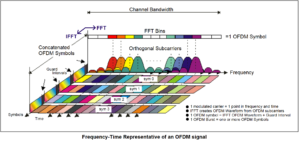From radios to core networks, a consensus is forming that 6G needs to offer more focused technology than 5G, or is it more technology? Energy, spectrum, and AI top the list of what 6G needs. EE World spoke with four engineers who attended the March 3GPP meeting in Korea. Here’s what they had to say.
If you ask people, “Has 5G been successful?” you get different answers depending on who you ask. With discussions surrounding 6G intensifying, the telecom industry is moving toward determining what to include in 3GPP Release 21, scheduled for release late this decade. EE World spoke with Stephen Douglas of Spirent, Milind Kulkarni of InterDigital, Paul Harris of Viavi, and Juan Montojo of Qualcomm, all of whom attended the 3GPP workshop that took place at Inchun, Korea in March 2025. Several issues emerged, the most notable of which is that 5G tried to be too many things for too many applications. Its complexity resulted in several lessons that 6G needs to address. At the same time, people also wanted new features.
What 5G brought to the table
Figure 1. 5G use cases focused on enhanced mobile broadband, machine-to-machine communications, and ultra-reliable low-latency communications. (Image:)
Figure 1 shows enhanced mobile broadband (eMBB), which relates to smartphones. 5G promised significantly faster download speeds compared to LTE. We also expected 1 ms latency and many more connections, called ultra-reliable low-latency communications (URLLC), than LTE. Finally, 5G promised machine-to-machine communications (MTC). All of these features work through an updated radio (5G New Radio, 5G NR) and a new core network.
Like LTE, 5G NR uses OFDM. While 5G provides a moderate speed increase, it’s hardly enough for users to notice. That resulted in the consumer telecom pundits calling 5G a flop. The far greater speeds that carriers hyped (and hoped for) were to come from mmWave frequencies starting at 24 GHz. That hardly materialized because mmWave’s short range requires many more cells than frequencies below 7 GHz. We thought we’d see a small cell on every light pole, but deployment costs mostly killed it. Today, mmWave seems relegated to special uses such as stadiums, arenas, fixed wireless access, and possibly private networks. All four people I spoke with agreed that mmWave now received little to no attention at the March 3GPP Workshop.
Since the initial 5G release (3GPP Release 15 in late 2018), we’ve seen enhancements such as reduced capability (RedCap) and private networks. These capabilities fall outside of eMBB. Instead, they target IoT and industrial applications. Such use cases may still occur, but business needs financial reasons to adopt new technologies. Let’s see what happens over the next several years.
Several needs emerged from my discussions, starting with energy efficiency, though the standards may not entirely address that and it may be more market-driven. The following topics, while addressed separately here, all incur overlaps, especially when it comes to AI.
Energy efficiency: too much is never enough

Juan Montojo
“Energy efficiency was an afterthought in 5G NR,” said Montojo. That’s why, when early 6G discussions and conferences began, energy efficiency topped the list. Later on, the user experience eclipsed energy efficiency for the top spot. Now energy use back on the table for the network, the radio, and even the mobile device. 5G did address energy consumption in 3GPP Release 16 through adaptive MIMO layer reduction.
“Energy efficiency is going to be designed [into 6G] from day one and starting with how the call flow works,” said Kulkarni, “it will affect how the commands are sent and how many times they’re sent.” The idea here is to build intelligence into the network so it can decide which packets contain important information to the user and which don’t. Right now, when a packet error occurs, the network resends it until the sender receives notification that the packet has been successfully received. If packets that contain unneeded information are not resent, the network uses less energy.

Milind Kulkarni
AI can be a tool for improving energy efficiency in networks and devices. Kulkarni also noted that networks can use AI/ML to learn how the network is used in certain regions and certain sections. From that information, AI can then perform load balancing by deactivating features when not needed. For example, putting a radio to sleep during times of little use.

Paul Harris
Harris took a different stance by emphasizing the user experience, which, as Montojo noted, can be a major energy sink. “Energy efficiency is great, but it’s also the user experience. That’s predominantly going to be a discussion between vendors and carriers as to what vendors are willing to do. Operators will have to drive vendors to be more energy efficient.”
Montojo suggested that telecom operators need to push their suppliers to develop equipment with lower energy consumption.
6G Radio? Maybe not
5G NR brought a different architecture compared to 4G radios. Both 5G NR and LTE use OFDM shown in Figure 2. 5G NR provided a small boost but most users barely noticed it. The consensus with 6G appears to lean toward an enhanced OFDM architecture. Nobody has gone so far as to call it 6G NR. This time, the focus could be more on energy efficiency than higher performance. While lower energy use can lower operator costs, it does nothing for the user.

Figure 2. 5G radios use orthogonal frequency division multiplexing. Image: Keysight Technologies
Montojo expects to see 6G radios in the OFDM family, which 5G NR uses. He foresees new functionalities or new codes, which don’t exist today, to improve the radio at the physical layer before touching the protocols. “Whether it’s a 5G/6G NR or LTE, it has to basically use the same grid. In that sense, a completely new type of waveform is unlikely because of that coexistence.”
Harris added by saying “There may be some corner cases where new waveforms could provide enhanced performance, but a significant departure from OFDM seems unlikely overall.”

Stephen Douglas
Douglas noted that there’s as yet no consensus on radio architecture based on the March 3GPP workshop discussions.
More spectrum, always
If there’s one thing everyone agrees on, it’s that the wireless industry needs more spectrum. According to GSMA, the cost of attaining spectrum has increased by 63% from 2014 to 2024. At the same time, spectrum available to wireless operators has nearly doubled, according to the linked report. Still, everyone agrees that more spectrum is needed. Improved spectral efficiency helps, but not enough. The so-called FR1 range (under 7 GHz) is getting increasingly crowded and FR2 mmWave frequencies aren’t the answer except in specific cases noted above.
“With 6G, the World Radio Conference (WRC) in 2023, people began looking at 7 GHz to 24 GHz as a frequency range for use with for 6G,” said Montojo. “There’s a lot of discussion happening closer to 7 GHz. People are more interested in that frequency because it’s a natural extension of what’s currently used by cellular networks at 3.5 GHz.” The frequency band from 7 GHz to 24 GHz is often referred to as FR3, though some consider it to run from 7 GHz to 12 GHz or 15 GHz.
“Extending from 3.5 GHz to 7 GHz is not a moonshot,” added Kulkarni. “When you get to 12 GHz and above, the physics start to change but it’s not as bad as mmWave.”
Douglas noted that the industry needs FR3 to enable new services, saying that’s where the priority will be. He notes that FR3 brings more contiguous spectrum than FR1. That brings an opportunity in most countries to achieve 400 MHz channels and provide better service. “Fewer carrier aggregations means better spectral efficiency, so there’s a lot of wins in it.” He disagreed, however, with the notion of needing additional spectrum. “You don’t necessarily need additional new spectrum bands. Most of it could be potentially extended, and that’s maybe what will happen. FR3 will still have the same propagation issues as mmWave.” That’s an argument for keeping any new additional spectrum below 12 GHz. It’s a tradeoff between FR1 with better propagation, and FR2 with greater bandwidth but short range.
New features because we need them, right?

Figure 3. 6G could add integrated sensing and communication, immersive communication, AI, and ubiquitous communication. Image: ITU
When the 6G discussions began, the focus was on use cases. That was before we learned how 5G use cases have been slow to take off. Even with the slow adoption of MTC and URLLC, we’ve seen strong emphasis on use cases for 6G, with less emphasis on smartphones and more on business use cases. Consumer wireless seems to have topped out unless the industry can develop a network with drastically faster speeds that can support new “killer apps” yet to be developed. As Figure 3 shows, 6G could have features such as Integrated communication and sensing (ISAC), which appears to be the new feature most discussed.
“ISAC is a new area that we’re excited about,” said Kulkarni. “At InterDigital, we’re doing a lot of work in that area.”
“Towers with antennas are extremely well positioned to sense the environment,” added Montojo. “Add to that the users, the subscribers, and the cellphones on the ground.”
Other features in Figure 3 include immersive communication. Shown as an outgrowth of eMBB, immersive communication was once called holographic communication. Ubiquitous connectivity refers to the integration of terrestrial cellular, satellite, and Wi-Fi communication. The dream here is that you’re seamlessly connected everywhere, from oceans to cities to indoors.
These new features and potential use cases might make you question the simplicity that some feel 6G should address. The way I see it, people want simplicity while at the same time calling for new features. Can we have both? Tell us what you think by leaving comment.
LTE core no more
5G promised an updated core network. The standards, however, allowed for both standalone (SA) and non-standalone (NSA) networks. On NSA networks, data would travel through a 5G radio network while control signals still use an LTE core. It seemed like a good idea at first because it provided a method to get 5G radios deployed (and therefore hyped) sooner than waiting for full 5G SA networks.
NSA, according to Harris, was seen as quite complicated and it prevented a lot of the benefits of 5G because the 5G core wasn’t an immediate easy rollout. He noted that a lot of it was more a “4G+” kind of situation where operators had a 5G radio but needed — and still need — a 4G anchor. Many networks around the world still use NSA. 6G will require at minimum of a 5G core, probably an enhanced core. That should bring about the end of NSA in most areas of the world.
Everyone has a wish list. Kulkani suggested adding a data plane to 6G, which Douglas referred to as a computer plane. Douglas also noted calls for a security plane as well.
6G will use AI everywhere. Kulkani explained that if we think about AI as network as one that gathers data, it can make that data available to run AI agents or AI services. The core network plays a big part in that. “It [the 5G core] has a data analytics function currently there. That function could add the intelligence needed to know which packets to resend and which to ignore, thus saving energy. How the whole data plane and data management aspects get defined will have some bearing on how the 6G code will be designed.”
AI to the core
You can expect to see AI designed into all parts of the network, especially in the core and in the radio. So far, how AI will be used is up in the air. As Montojo said, “Every group [at the 3GPP workshop] was trying to use AI for their own purpose, and there is no unified framework within 3GPP nor across groups. This is going to change because now we know we’re going to have pervasive AI. We’ll have it in many parts of the network — at the core network, at the radio, at the UE, and at the devices. We need to have something that effectively enables a unifying framework for things such as data collection.” That data processing will take place in the core, at the edge or both.
“Cloud native should be the design principle, and AI should be native, integrated into the network from day one,” added Douglas.
Last word
6G seems full of contradictions. For example, we often hear people pushing simplicity. At the same time, others want more features, services, use cases, and AI. We want more and we want less. What people really want is more revenue at a lower cost.
If people want a less complex network with features aimed at business use, what could that mean for you and your smartphone?
“I’m not expecting a big bang with 6G in terms of the market and marketing,” said Douglas.
I disagree. Marketers will be marketers. See you at the end of the 2020s.
Filed Under: 6G, AI/ML, Featured, mm Wave, mmWave, Satellite Comms, Sustainability, URLLC



